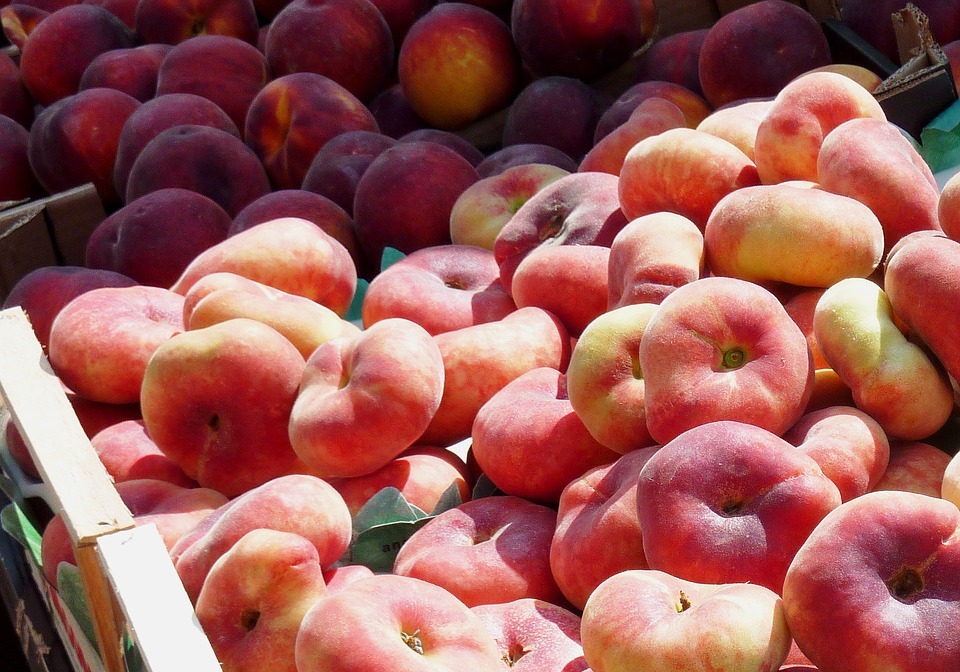This comprehensive article aims to answer the question of whether dogs can safely enjoy peaches, exploring both the potential benefits and risks involved. We will examine the nutritional composition of peaches, delve into the potential health hazards they might pose, and offer practical advice on how to safely introduce this fruit into your dog's diet. We'll address common concerns about peach consumption in dogs, providing detailed information on proper preparation techniques, identifying signs of potential issues, and exploring alternative fruit options. Whether you're a seasoned dog owner or just starting your journey with a furry friend, this guide will equip you with the knowledge necessary to make informed decisions about your dog's dietary choices.
Part 1: The Nutritional Value of Peaches

Peaches, a popular summer fruit, are not only a delicious treat for humans but can also offer some nutritional benefits for dogs.
1.1 Vitamins and Minerals
Peaches are a rich source of essential vitamins and minerals that contribute to your dog's overall health and well-being. These include:
- Vitamin A: Plays a crucial role in maintaining healthy vision, skin, and immune function. It also supports growth and development in puppies.
- Vitamin C: A potent antioxidant that strengthens the immune system, helping to protect against cell damage caused by free radicals. Vitamin C also promotes collagen production, which is essential for healthy skin, tendons, and ligaments.
- Potassium: A vital electrolyte that regulates fluid balance, maintains healthy blood pressure, and supports proper nerve function. Potassium is particularly important for dogs with heart conditions or kidney issues.
- Fibre: Promotes healthy digestion by adding bulk to stool, which can help prevent constipation. Fibre also helps regulate blood sugar levels and can contribute to a feeling of fullness, potentially aiding in weight management.
1.2 Antioxidants
Peaches contain a variety of antioxidants that help protect your dog's cells from damage caused by free radicals, which are unstable molecules that can contribute to aging and disease.
- Beta-carotene: A precursor to vitamin A, beta-carotene is converted into this essential vitamin in the body. It plays a vital role in vision, immune function, and skin health.
- Lutein: A powerful antioxidant that protects against damage to the eyes, particularly the retina, which is responsible for vision.
- Lycopene: A carotenoid that acts as a potent antioxidant, potentially reducing the risk of certain types of cancer. Lycopene is also known for its anti-inflammatory properties.
Part 2: The Potential Risks of Feeding Peaches to Dogs

While peaches offer some nutritional benefits, it's essential to be aware of the potential risks associated with their consumption.
2.1 Cyanide Content
Peaches, like other stone fruits (such as apricots and plums), contain a naturally occurring compound called amygdalin. When ingested, amygdalin breaks down into cyanide, a toxic substance. However, the amount of cyanide present in a typical peach is generally low and unlikely to cause harm to a healthy dog. The real danger lies in consuming large quantities of peach pits or leaves, which contain significantly higher levels of amygdalin.
2.2 Digestive Issues
The high fibre content in peaches, while beneficial in moderation, can lead to digestive upset if consumed in excessive amounts. This may manifest as diarrhoea, vomiting, bloating, or gas.
2.3 Allergies
Some dogs may be allergic to peaches, with symptoms ranging from mild to severe. Signs of an allergic reaction include:
- Itching: Excessive licking, scratching, or rubbing, particularly around the face, ears, and paws.
- Swelling: Swelling of the face, lips, or tongue.
- Redness: Skin redness or hives.
- Difficulty breathing: Wheezing, coughing, or laboured breathing.
If you suspect your dog is experiencing an allergic reaction to peaches, seek immediate veterinary attention.
2.4 Sugar Content
Peaches are naturally sweet and contain a moderate amount of sugar. While this is generally not a concern for healthy dogs, it's important to be mindful of sugar intake for dogs with pre-existing health conditions such as diabetes.
Part 3: How to Safely Feed Peaches to Your Dog

With the potential risks in mind, it's crucial to learn how to safely introduce peaches into your dog's diet.
3.1 Preparation
Proper preparation is key to ensuring your dog can safely enjoy peaches.
- Ripe Peaches: Choose ripe peaches for easier digestion. Ripe peaches are typically softer and have a more fragrant aroma.
- Thorough Washing: Wash peaches thoroughly to remove any dirt, pesticides, or other residues that may be harmful to your dog.
- Pit Removal: The peach pit should always be removed before feeding peaches to your dog. It contains amygdalin, which can be toxic, and also poses a choking hazard.
- Small Pieces: Cut peaches into small, bite-sized pieces to make it easier for your dog to chew and swallow. This helps prevent choking and digestive issues.
3.2 Moderation
Moderation is key when feeding peaches to your dog. Start with a small amount, such as a teaspoon or two, and observe their reaction closely. If they show no signs of adverse effects, you can gradually increase the portion size.
3.3 Dog Breed Considerations
Certain dog breeds may be more prone to digestive issues or allergies. It's important to be extra cautious when feeding peaches to:
- Small dogs: Due to their smaller mouths and stomachs, small dogs may be more susceptible to choking hazards and digestive upset.
- Dogs with sensitive stomachs: Dogs with pre-existing digestive issues may experience more severe reactions to high-fibre foods like peaches.
- Dogs with known food allergies: If your dog has a history of food allergies, it's crucial to consult your veterinarian before introducing peaches or any new food. They can advise on safe alternatives and monitor your dog for any signs of allergic reaction.
Part 4: Signs of Peach Toxicity in Dogs
If your dog has ingested a large amount of peach pits or leaves, or exhibits any signs of poisoning, it's crucial to seek veterinary attention immediately. Signs of peach toxicity in dogs may include:
- Difficulty breathing: Laboured breathing, wheezing, or gasping for air.
- Dilated pupils: Pupils that appear larger than normal.
- Weakness: Lethargy, stumbling, or difficulty standing.
- Vomiting: Frequent or forceful vomiting.
- Diarrhoea: Loose or watery stools.
- Seizures: Uncontrolled muscle contractions or tremors.
Part 5: FAQs
Here are answers to some common questions about feeding peaches to dogs:
5.1 Can I give my dog a peach pit?
No, under no circumstances should you ever give your dog a peach pit. Peach pits contain amygdalin, which breaks down into cyanide, a toxic substance. Ingesting peach pits can lead to serious health problems, including cyanide poisoning, and can even be fatal.
5.2 How much peach can I give my dog?
The amount of peach you can safely give your dog depends on their size and breed. Start with a small amount, like a teaspoon or two, and monitor their reaction closely. If they tolerate it well, you can gradually increase the amount over time. However, always remember to keep peach consumption in moderation and avoid giving them large quantities.
5.3 What if my dog eats a peach pit?
If your dog has ingested a peach pit, closely monitor them for any signs of toxicity. Seek immediate veterinary attention if you notice any symptoms like difficulty breathing, dilated pupils, vomiting, or diarrhoea. Time is of the essence in treating potential cyanide poisoning.
5.4 Are peaches good for dogs with diabetes?
Peaches are high in sugar, which can be detrimental to dogs with diabetes. If your dog has diabetes, it's crucial to consult with your veterinarian before giving them any peaches or other sugary treats. They can provide specific dietary recommendations tailored to your dog's individual needs.
5.5 Can dogs eat canned peaches?
Canning processes can alter the nutritional content of peaches, and some canned peaches may contain added sugars or preservatives, which can be harmful to dogs. It's generally advisable to avoid feeding your dog canned peaches. Fresh or frozen peaches are safer alternatives.
5.6 Is it okay to give my dog peach skin?
Peach skin is generally safe for dogs to eat, but it can be tough to digest. While removing the skin before feeding peaches to your dog is not essential, it's usually a good idea to remove it, especially for smaller dogs or those with sensitive stomachs.
5.7 Are there any other fruits my dog can eat?
Yes, many other fruits are safe for dogs to eat in moderation. Some safe options include:
- Apples (without seeds)
- Bananas
- Blueberries
- Strawberries
- Watermelon (without seeds)
Always remember to remove any seeds or pits before feeding fruits to your dog.
It's also important to introduce new fruits gradually, starting with a small amount and monitoring your dog for any adverse reactions. If you have any concerns about your dog's diet, consult with your veterinarian for personalized guidance.
Everyone is watching
-

Can Dogs Eat Bananas? A Guide to Safe Treats
DOGS & PUPPIESThis comprehensive guide will delve into the world of canine nutrition, focusing on the popular question: can ...
-

Can Dogs Eat Oranges? (Is It Safe or Toxic?)
DOGS & PUPPIESThis article delves into the question of whether dogs can safely consume oranges. We'll explore the nutrition...
-

Can Dogs Eat Grapes? The Shocking Truth About This Fruit
DOGS & PUPPIESThis article delves into the controversial topic of grapes and dogs, exploring the potential dangers associate...
-

Why Do Dogs Eat Poop? Understanding Coprophagia in Dogs
DOGS & PUPPIESThis article delves into the perplexing phenomenon of coprophagia, the act of eating faeces, in dogs. We explo...
-

Can Dogs Eat Shrimp? A Guide to Safety and Risks
DOGS & PUPPIESThis comprehensive guide dives into the world of shrimp and dogs, exploring the potential benefits and risks a...
